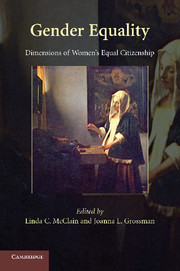Book contents
- Frontmatter
- Contents
- Contributors
- Acknowledgments
- Gender Equality
- Introduction
- PART I CONSTITUTIONAL CITIZENSHIP AND GENDER
- PART II POLITICAL CITIZENSHIP AND GENDER
- PART III SOCIAL CITIZENSHIP AND GENDER
- 10 Pregnancy and Social Citizenship
- 11 Equality: Still Illusive After All These Years
- 12 Razing the Citizen: Economic Inequality, Gender, and Marriage Tax Reform
- PART IV SEXUAL AND REPRODUCTIVE CITIZENSHIP
- PART V GLOBAL CITIZENSHIP AND GENDER
- Suggested Readings
- Index
- References
11 - Equality: Still Illusive After All These Years
Published online by Cambridge University Press: 05 August 2012
- Frontmatter
- Contents
- Contributors
- Acknowledgments
- Gender Equality
- Introduction
- PART I CONSTITUTIONAL CITIZENSHIP AND GENDER
- PART II POLITICAL CITIZENSHIP AND GENDER
- PART III SOCIAL CITIZENSHIP AND GENDER
- 10 Pregnancy and Social Citizenship
- 11 Equality: Still Illusive After All These Years
- 12 Razing the Citizen: Economic Inequality, Gender, and Marriage Tax Reform
- PART IV SEXUAL AND REPRODUCTIVE CITIZENSHIP
- PART V GLOBAL CITIZENSHIP AND GENDER
- Suggested Readings
- Index
- References
Summary
The title of this chapter owes a debt to Paul Simon, although his phrase is “still crazy after all these years.” He uses it to describe the feelings that are generated when he meets an “old lover” on the street, who seems glad to see him. After a few beers together, they go their separate ways, and he reflects on the fact that he is not the kind who tends to socialize, but seems to “lean on old familiar ways,” “longing [his] life away,” “still crazy after all these years.” I think of equality as that old lover, as illusive as ever, meeting and mixing, then going its separate way, leaving the feminist leaning and longing for it – still crazy after all these years.
In this chapter, I will propose that one way to render equality less illusive is to move beyond gender and build a more comprehensive framework on the concept of universal human vulnerability. I propose a new theoretical investigation, one that focuses on privilege as well as discrimination and reflects on the benefits allocated through the organization of society and its institutional structures. Such an approach could move us closer to securing substantive equality and social rights in the United States.
The concept of equality is traditionally associated with the rise of the philosophy of liberal individualism. It also is often cited as the key animating principle of modern feminism.
- Type
- Chapter
- Information
- Gender EqualityDimensions of Women's Equal Citizenship, pp. 251 - 266Publisher: Cambridge University PressPrint publication year: 2009
References
- 3
- Cited by



